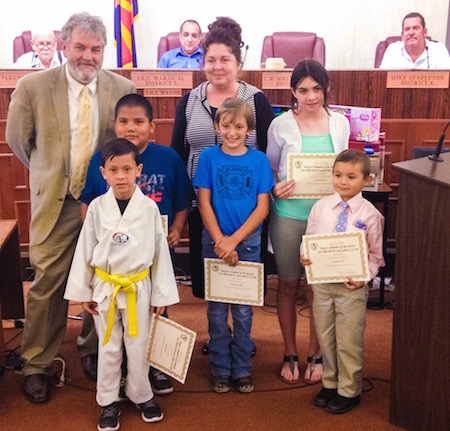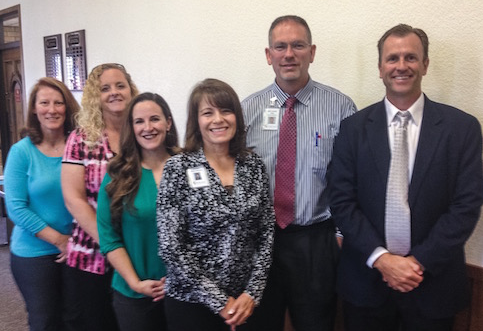
MAY 2016
REGULAR MEETING OF THE
GILA COUNTY BOARD OF SUPERVISORS
Tuesday May 3, 2016 10:00 AM Gila County Courthouse
Gila County will be getting 12 new dash cams. The decision
to buy them was made after a presentation by Gila County
Sheriff Adam Shepherd at yesterday's Board Of Supervisors
meeting. The 12 cameras, made by WatchGuard, will outfit
one third of sheriff's fleet at a cost of over $5,000 each,
totaling almost $67,000.
KQSS' Jon Cornell asked the Sheriff why he didn't get $60
dash cams from amazon.com. Shepherd explained that these
units were much more sophisticated, loaded with numerous
features, perhaps the most important of which is they meet
the standards required by the justice system to be used as
evidence. The sheriff said he'd like to be able to get body
cameras at some point, but they're too expensive to consider
now.
The Tonto National Forest is in the process of formulating an
Environmental Impact Study on the Resolution Copper
Project. Part of the process is a public comment period. The
Supervisors voted unanimously yesterday to voice their
official support of the Project and the Land Exchange.
Chairman Mike Pastor emphasized the importance of the
coming mine to the area.
How much does it cost to pave half a mile of road? Based
on the IGA passed at the meeting, over $200,000. That's the
projected cost for the county's half of paving a portion of
Payson's Houston Mesa Road. The city of Payson will pay
for the other half.
County Manager Don McDaniel announced that the budget
process for fiscal year 2016-17 starts next week.
REGULAR MEETING OF THE
CITY OF GLOBE MAYOR AND COUNCIL
Tuesday May 25, 2016 6:00 PM City Council Chambers
It's going to cost a bit more to live in Globe, after decisions
made at Tuesday night's Regular Meeting of the City of
Globe Mayor and Council. There was a public hearing over
the proposed adjustment of the water and wastewater rates.
Globe resident Charlene Giles asked the Council to consider
what she termed as “more fair rates”, a sliding rate based on
use for wastewater and trash, rather than the flat rates in
place. It's an issue she has raised multiple times before.
City Manager Paul Jepson said there were no plans to alter
the type and structure of rates at this time, but that the rates
could later be modified without impacting the existing
proposal. Later in the meeting, the Council unanimously
passed a 10.4% increase in water and wastewater rates,
which will go into effect in 60 days.
Town of Miami Manager Joe Heatherly gave a presentation
on the economic state of the area's Cobre Valley Community
Transit. To meet expenses, he proposed a three way split
between Globe, Miami and the County, with each
contributing $61,000 annually. Heatherly mentioned that
80% of the transit customers originate in Globe. City
resident Susan Fields pleaded with the Council to support
the transit program as it is a much needed service for older,
retired and disabled citizens. She said she's been talking to
friends in the Valley about this being a good place to retire,
and part of the reason is good public transportation.
Finance Director Joe Jarvis presented the 2016-17 annual
budget. There's a $303,000 deficit that the city plans to cover
by a slight raise in the local sales tax rate. There's also a
proposal for a temporary 1% increase in sales taxes locally
to cover the $10 million unfunded liability for pension
benefits. Jarvis explained that a 1% increase in Globe's sales
tax would generate approximately an additional $2 million a
year in revenue. Discussion was also had over going to the
state legislature to change the laws to make it possible for
municipalities to get loans to pay off the entire amount,
which would save the town considerably. The present
structure of Arizona law does not allow for this, but Jarvis
and Jepson feel that presented properly, the state might be
amenable, though it could be over a year for that to happen.
Most in the audience were drawn to the meeting because the
bed tax was on the agenda. Globe's bed tax is earmarked for
economic development and is capped at $100,000 a year.
But it's projected that next year, it will bring in $150,000.
The money will be distributed as it has been in the past-to
the Chamber of Commerce, the Downtown Main Street
program, the Cobre Valley Center for the Arts, the Gila
County Historical Society, and the Southern Gila County
Economic Development Corporation. Several attendees
spoke to support the continuation of the tax.
One thought on the bed tax brought up by the Council was
that the excess of $50,000 could be used for the extra money
needed to fund Cobre Valley Transit. Mayor Terry Wheeler
concurred saying the transit program strengthens our
community.
Branch Executive Aimee Staten gave a presentation on the
First Quarter 2016 financial report for the Boys and Girls
Club locally. In October, there were 97 members. Now,
there are 148 members. Staten hopes to grow the club to
200 kids a day by next year. There are future plans for a new
building.
The Mayor's Boys and Girls Club Members of the Month
were announced. For January its Ebed DeLosReyes and CJ
Leverence. February honored Cli Watson and Jessie
Techelle Reichelt, and chosen for March were Hezekiah
Palmer and Jayda Thompson.
In other water news, Globe is refurbishing the Hayden and
Cutter tanks and they'll be getting figures soon on estimates
for the Apache Peak and Thompson tanks.
It was decided to lease rather than buy a road broom, a
vehicle that cleans debris from roads after rainstorms. The
Council approved a cooperative lease agreement with
Empire Cat.
RICO funds gained through drug seizures will be used for
the purchase of a couple of 2017 Ford Police Interceptor
SUVs from McSpadden.
Police Chief Mark Nipp announced an agreement with
Cobre Valley Regional Medical Center for some space in
CVRMC's expansion to be used as a substation. The
hospital's public relations director, Evelyn Vargas, noted it
will bring added safety and security to patients and staff.
Director of Planning and Zoning, Chris Collopy drafted a
letter in support of Resolution Copper during the NEPA
comment period. Usually such a letter would be signed by
the mayor, but Collopy is going to redraft it so that it can be
signed by everyone on the Council.
Councilmember Lerry Alderman reported spending time
with Councilmember Mike Humphrey who is now at home
but still very sick. Mayor Wheeler asked that we keep Mike
in our prayers. Councilmember Mike Stapleton commented
on Globe Clean and Beautiful saying that last weekend's
volunteers did a great job.
And Councilmember James Haley announced the good news
that Globe will have a bowling center again. The old
bowling alley on East Ash has been purchased. It will be
completely rehabbed and opened as The Copper Lanes in
January.


Gila County Board of Supervisors Work Session
Tuesday May 31, 2016 10:00 AM Gila County Courthouse
Gila County's biggest health priorities are obesity, substance
abuse, access to quality medical care (including mental
health care) and sexual health, according to results of the
2015 Community Health Assessment and the 2016-2020
Community Health Improvement Plan, which were
presented at Tuesday morning's Gila County Board of
Supervisors Work Session.
Director of Health and Emergency Services, Michael
O'Driscoll introduced the presentation, which was given by
Adrienne Udarbe, the Executive Director of Pinnacle
Prevention, a consultant to the county.
The Community Health Assessment was based in part on US
Census data, along with self reporting from respondents,
including 637 interviews with Gila County residents, six
focus groups containing a total of 49 Gila County residents
and 14 interviews with Key Informants.
73% of the respondents were female and most had at least
some college attendance. 76% were white, 15% Hispanic.
25% were from Payson, 36% from Globe, 12% from Tonto
Basin, 6% from Miami and almost 5% from Young. San
Carlos respondents were less than 1%.
Supervisor Tommie Martin said she would like to see the
results of the survey separated into Northern and Southern
Gila County, as the Globe area has a permanent resident
base, while Payson is mostly transient, with many second
homes and people coming and going. Martin was
disappointed in the lack of participation from Payson
residents, and was also concerned about the lack of San
Carlos data, at less than 1% of the total when it accounts for
1/3rd of the population- a problem that was more
pronounced by what she speculated was the needs of San
Carlos residents potentially being very different from the rest
of the County.
Chairman Mike Pastor agreed, and all three supervisors
discussed the need to be directly involved in the next survey
to work toward getting results that would be more reflective
of the population.
The reasons behind the two surveys went beyond Gila
County's desire to ascertain the needs of residents here. The
data is a requirement for many of the grants the County and
cities within it are trying to secure.
The Assessment compared Gila County to similar counties
across America demographically. Population size, growth,
density, mobility, age, gender and race were considered
along with percentages for foreign born, high school
graduates, unemployment, single parent households, home
values, home ownership, household income and poverty
rates, among the major indicators.
Compared to the rest of Arizona, Gila County is older,
whiter, less educated and more unemployed. The percentage
of Native American residents is over three times larger than
elsewhere in the state.
Compared to similar counties across the country, Gila
County residents are significantly more likely to die from
cancer- a statistic that didn't surprise Supervisor John
Marcanti, who cited the area's history of the blowback from
nuclear testing and the spraying of Agent Orange.
Disease rates where Gila County was much higher than
comparative counties included gonorrhea, chlamydia,
diabetes and obesity.
Health behavior outcomes where Gila County fared worse
than comparative counties included high rates of teen
smoking, alcohol and marijuana use and teen pregnancies.
Adult binge drinking and cigarette smoking was somewhat
higher, and physical inactivity significantly higher than
comparative counties. The area is also plagued with low
rates of residents receiving preventative health care.
Almost 20% of Gila County adults below Medicare
eligibility age did not have health insurance. When asked
how to describe their overall health, over 37% rated it very
good, another 37% rated it good and over 11% considered it
excellent. Over 10% rated it fair and only 3% called it poor.
Social factors where Gila County was ranked below similar
counties across the country included a high rate of single
parent households, children living in poverty, inadequate
social support, violent crime and a low rate of home
ownership.
Regarding Glia County's Environment, it was worse than
similar counties in many indicators including most
significantly child food insecurity and stressed housing. But
the one statistic that caught the attention of KQSS' Jon
Cornell was that only 3% of the residents lived within half a
mile of a park. How could that be, he wondered, when the
county is 97% public land? The answer came in the
definitions controlling the results. Only city and county
parks were considered as parks.
The 14 Key Informants included the City of Globe, various
school districts, First Things First, Head Start, the Cobre
Valley Regional Medical Center, Southwest Behavioral
Health, Horizon, Heritage Health Care, the Globe and Miami
senior centers, and the Tonto Apache Tribe.
The Cobre Valley Regional Medical Center's Neil Jenson,
Evelyn Vargas, Celena Cates and Paula Horn were also in
attendance. Vargas mentioned CVRMC's One Call service,
providing help for virtually all health care needs including
referrals to the specialists and agencies in the area.
O'Driscoll was pleased with the results and announced that
data gathering will continue including annual reports to the
public. Full results of both assessments are online at
gilacountyaz.gov.
LR: Celena Cates, Paula Horn, Adrienne Udarbe, Evelyn
Vargas, Neil Jenson, Michael O'Driscoll










